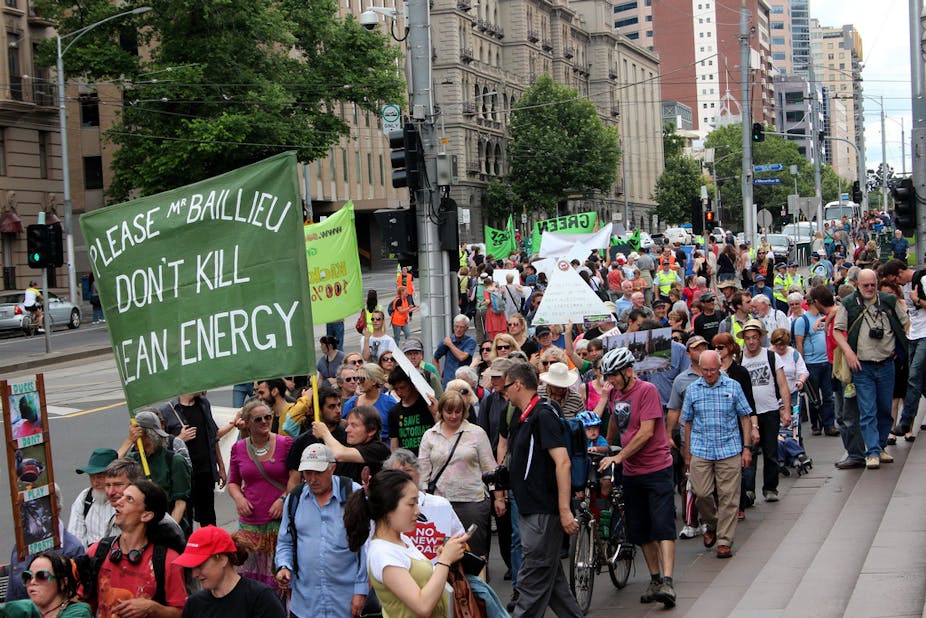The bill creating the carbon price has passed through Parliament. However, the campaigning efforts of the environmental lobby will not pause. More than ever, the coal industry is in its sights, with court cases against Xstrata in Queensland and HRL in Victoria now underway.
Getting regional Victoria’s Hazelwood power station closed is a potential prize from the cross-party climate deal that gave us the climate price. But it will not realise campaigners’ ultimate goal of a carbon-neutral economy.
Environmentalists know that they have achieved all that they can for the moment through the legislature. For decades, politicians’ attention has been captured by Australia’s most greenhouse intensive industries. Throughout the carbon debates, environmentalists have not been able to avert that attention.
Recommendations were made for legislative reform that would institute a greenhouse gas trigger for environmental assessments under the Environment Protection and Biodiversity Conservation Act, but these have been ignored or rejected. The Gillard government has been convinced by the yet-to-be proven argument that a market mechanism - the emissions trading scheme - will curtail emissions-intensive industrial developments as effectively as scrutinising, evaluating or simply prohibiting them.
The courts are the next stage for the environmentalists’ battle against coal.
Past efforts at halting coal mining activities and power generation activities through the courts have been unsuccessful. Australian courts and tribunals have held that in some circumstances, decision-makers must consider the greenhouse gas emissions from coal-fired power in deciding whether to approve coal mines and power stations.
But these decisions have not stopped projects. They have simply required ministers to explicitly preference the promised economic windfalls from coal mines and power stations over environmental objectives.
Most notably, the Federal Court has twice rejected challenges to New South Wales and Queensland coal mines. The court was not satisfied that there is a sufficient link between localised burning of coal and climate change to prove that carbon emissions could have “significant impacts” on the Australian environment, particularly on ecosystems like wetlands and reefs, which are highly vulnerable to sea level height and temperature change.

Two cases currently before state courts and tribunals take a different legal approach. Environmental groups have joined with sympathetic lawyers to bring suits against coal that will subject the coal projects to merits assessment.
In Queensland, a decision of the Land Court is imminent in the case between Friends of the Earth and Xstrata in relation to the Wandoan coal mine.
This case is not simply a challenge to the environment or planning approval for the project. Rather, the environment group is also seeking to prevent the grant of the mining tenure required by Xstrata. They are arguing that the coal mine, which will be Australia’s largest and will principally service the export market, will indirectly and notably contribute to climate impacts that are “irreversible, of a high impact and widespread”.
Under the relevant law, the Friends of the Earth must convince the court that the adverse impacts of the mine are of such a magnitude to justify its rejection. It is a case that has parallels with the long-fought battle against sand mining on Fraser Island, which started in the Mining Warden’s Court of Queensland in the early 1970s and made its way to the High Court.
In Victoria, a group of environmental objectors, most publicly led by Environment Victoria, are party to a current Victorian Civil and Administrative Tribunal case. It concerns the works approval the Environment Protection Authority gave a combined coal- and gas-fired power plant proposed for Victoria’s Latrobe Valley.
The legal question for the tribunal is whether this project, characterised by the proponent as a clean coal alternative to the status quo, is “best practice” to manage greenhouse gas emissions. Does polluting less than the typical coal-fired power station - but far more than generation from gas or renewables - correspond with best practice standards?
The tribunal’s finding will be significant because it will also inform us whether Victoria’s new Climate Change Act, which must be considered in this case, actually stands for something.
Regardless of the outcomes of these cases, court battles between coal companies and environmentalists will continue. Legal alliances are being formed. Landholders, like those in Bacchus Marsh close to Melbourne, have been emboldened by the coal seam gas outrage initiated by farmers throughout New South Wales and Queensland and appear likely to join the fold.
Proposals to halt new or expanded coal developments will be opposed. Existing facilities, like Delta Electricity’s Lithgow plant - the subject of community-initiated court claims over pollution - will be scrutinised. The battle is important because it might just change public sentiment and government opinion about the future of coal in Australia.

